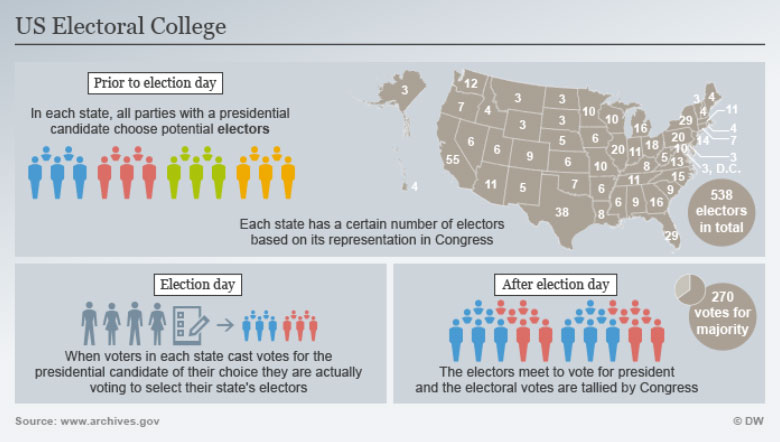How the Electoral College works to elect the President

Originally written on November 02, 2016
In the next issue of the newsletter, we should know who our next President will be; Election Day, as I am sure everyone has heard, is Tuesday November 8th. Election 2016 has certainly been unique already. For example, this is the first time a female has been nominated as a U.S. presidential candidate. This is monumental, considering that it has been less than one hundred years that women have had the right to vote (in 1919, the 19th Amendment to the U.S. Constitution was passed, barring discrimination against gender for the right to vote. As required, the amendment was ratified in 1920 by a three-fourths majority of all the states; the state that cast the deciding vote almost voted against it, but the state legislator’s mother convinced him otherwise).
Many international students—and Americans, for that matter—may be confused about talk of electoral votes and if the presidential candidates will have enough to win. The following is a quick explanation of the Electoral College (for more information take a look at this article).
In order to win the presidency, a candidate must receive at least 270 electoral votes out of 538 (the election is not decided by the popular vote). The Electoral College has a total of 538 electors—people with the right to vote in the presidential election. Who are these electors? They are individuals who have been nominated by their state’s legislature. In other words, when a U.S. voter casts his or her vote for the President, they are in fact voting for the electors of that state. In 48 out of 50 states (not including Maine or Nebraska), there is a winner-take-all system where the popular vote determines who the elector will choose as President and Vice President. The number of electors per state derive from the number of representatives from the two Chambers of Congress: the Senate and the House of Representatives. The Senate includes 100 senators (2 senators per state) and the House is comprised of 435 representatives, as well as the three representatives assigned to the District of Columbia, the capitol of the United States that is technically not a state.
In general, states with a larger population have more representatives. This is why the states with more electoral votes have more weight in the election, such as California, which has the most electoral votes with 55. Many states routinely vote either Republican or Democratic, which are the two major parties in the U.S.; the states considered to be “swing states” do not consistently vote for one party and could swing from one party to the other in each presidential election. This means that the presidential candidates spend most of their time campaigning in the swing states. In the 2016 election the swing states are thought to be Virginia, Colorado, Iowa, New Hampshire, Nevada, Florida, and Ohio. There could be others, including Georgia and North Carolina. These states don’t have as many electoral votes as Florida and Ohio, traditionally swing states with the most electors; therefore, much of the campaigning is often done in those two states.
I am not going to comment on who is the likely winner; you can read about all the polls, predictions, and opinions in the news. I think one thing is for sure, however: whatever the result, books will be written about how this election was unprecedented.
~Dana Riechman

